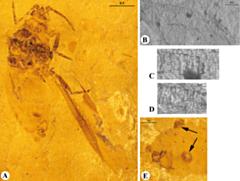Project 2587: D. Żyła, J. J. Hull, A. Homan, P. Wegierek. 2017. Polyphyly of the extinct family Oviparosiphidae and its implications for inferring aphid evolution (Hemiptera, Sternorrhyncha). PLOS ONE. 12 (4):e0174791.
Abstract
Aphidoidea, the so-called "true aphids" are one of the most challenging groups in terms of solving the phylogenetic relationships. Morphology-based analyses were strongly affected by widespread homoplasy, while the molecular-based attempts struggled with the lack of sufficient phylogenetic signal. Despite significant improvements, the higher classification still remains unresolved and rather controversial. However, the use of the fossil record, one of the most valuable sources of information, was mainly limited to calibration of a phylogenetic tree, without a direct inclusion into the analysis. The extinct family Oviparosiphidae has long been considered as the common ancestor of all recent Aphidoidea and it was used as a calibration point in several analyses, but it has been never analyzed in a phylogenetic context. The family has been treated as a monophyletic group purely based on the simultaneous presence of two abdominal structures, ovipositor and siphunculi. However, it has been shown recently that at least one more extinct lineage, present at the same time, was characterized by the same features. For these reasons, we performed a maximum parsimony analysis using morphological data for extinct aphid taxa to prove the monophyly of Oviparosiphidae. Our analysis shows that the presumed ancestor lineage of recent aphids is a polyphyletic group. Our results support the hypothesis of an early Mesozoic rapid radiation of aphids, which led to several different lineages characterized by both ovipositor and siphunculi. The results indicate the necessity of examining the other extinct families, and shows that the diversity of aphids before the Cretaceous Terrestrial Revolution (KTR) was higher than expected. Even though there is not enough data to perform a formal analysis, fossils seem to suggest a significant impact of the KTR on aphid diversification. Additionally, we have made a redescription of two genera and description of a new species, Vitimaphis subridens sp. nov.Read the article »
Article DOI: 10.1371/journal.pone.0174791
Project DOI: 10.7934/P2587, http://dx.doi.org/10.7934/P2587
| This project contains |
|---|
Download Project SDD File |
Currently Viewing:
MorphoBank Project 2587
MorphoBank Project 2587
- Creation Date:
07 January 2017 - Publication Date:
11 January 2021
Authors' Institutions ![]()
- University of Silesia
- Natural History Museum of Denmark
Members
| member name | taxa |
specimens |
media |
| Dagmara Zyla Project Administrator | 1 | 2 | 1 |
Project has no matrices defined.
Project downloads 
| type | number of downloads | Individual items downloaded (where applicable) |
| Total downloads from project | 68 | |
| Project downloads | 67 | |
| Document downloads | 1 | Complete character list in docx format (1 download); |

